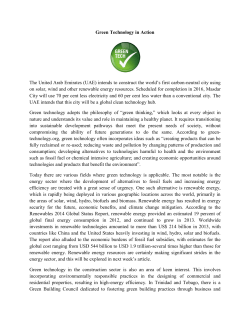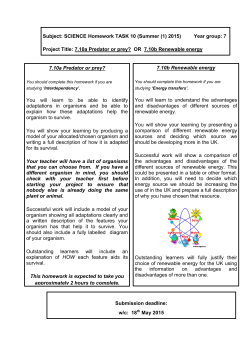
Backfeed, Safety, and Work Practices
Backfeed, Safety, and Work Practices Michael T. Sheehan, P.E. March, 2015 NREL is a national laboratory of the U.S. Department of Energy, Office of Energy Efficiency and Renewable Energy, operated by the Alliance for Sustainable Energy, LLC. NEC NESC Boundary Confusion NATIONAL RENEWABLE ENERGY LABORATORY Boundary between NESC and NEC Electricians tend to work on equipment that is “dead” (unpowered), to enhance safety. Electricians also tend to work with the lower voltages found in homes and businesses Utilities workers commonly work with live current to maintain power distribution. Utilities workers commonly work with the high voltages found in power lines Boundary Issues Street Lights; PUC Jurisdiction; Arc Fault Values Both the NESC and NFPA 70E include tables that provide the required rating of flame-resistant (FR) clothing for working with power up to 1,000 Vac. But the tables are not the same. The primary difference is that the NFPA 70E table values are based on calculations, while the NESC table values are a combination of arc energy levels from calculations and results from actual test results performed in a utility test lab Clarification of Scope 2012 Edition of the NESC standard now includes detailed language that specifies what the code covers for areas such as generation, transmission, and distribution of electricity NATIONAL RENEWABLE ENERGY LABORATORY Safety Safety in electric operations, for all employees and the public at large, trumps other considerations. Electric utility personnel perform both live-line work and work on ‘dead’ facilities. Live-line work requires principles of “insulate and isolate” to keep workers from dangers; assuring facilities are ‘dead’ requires the workers to work between grounds applied to the electric facilities being handled. NATIONAL RENEWABLE ENERGY LABORATORY NESC Requirements NESC Code NESC Requirements for De-energized Work • Section 444 of the NESC details requirements • Isolate - operate switches, disconnects and lockout /tag • Test for voltage • Install protective grounds on each side of the work location NATIONAL RENEWABLE ENERGY LABORATORY “Live-Line Work” vs. “Dead” Facilities Electric utility personnel perform both live-line work and work on ‘dead’ facilities. Live-line work requires principles of “insulate and isolate” to keep workers from dangers; Declaring facilities are ‘dead’ requires the workers to work between grounds applied to the electric facilities being handled. NATIONAL RENEWABLE ENERGY LABORATORY Backfeed –Tom Short book 4.10.4 4.10.4 Backfeeds During a line-to-ground fault where a single-phase device opens, current may backfeed through a three-phase load. It is a common misconception that this type of backfeed can only happen with an ungrounded transformer connection. Backfeed can also occur with a grounded three-phase connection. This creates hazards to the public in downed wire situations. Even though it is a weak source, the backfed voltage is just as dangerous. Lineworkers also have to be careful. A few have been killed after touching wires downstream of open cutouts that they thought were deenergized. NATIONAL RENEWABLE ENERGY LABORATORY Canadian Backfeed Study Conclusions •We could find no statistical evidence to suggest that Distributed Generation Facilities less then 500kW in size, create or experience a greater degree of back feed than other forms of customer load where back feed can potentially occur on a distribution system; •There was unanimous agreement among utility respondents, that adherence to safe work practice methods is the best means of ensuring worker safety involving back feed in the three common customer load scenario’s outlined in our survey. •Further work needs to be done to ensure that many current interconnection standards and their associated costs to DG owners reflect the true risks if any to the safety of utility assets, workers and\or the public. NATIONAL RENEWABLE ENERGY LABORATORY Canadian Utility Survey Results There was unanimous agreement by all survey respondents, that the best means of ensuring worker safety in the three potential backfeed scenario’s involves following established safe work practice methods rather then installing redundancy switches, transfer trip or other costly hardware solutions. NATIONAL RENEWABLE ENERGY LABORATORY Participant Testimonials: Mr. Georges Simarding, M.ing –Hydro Quebec “ Protection equipment is mainly to protect equipment and safe work practice is to protect people “ NATIONAL RENEWABLE ENERGY LABORATORY Failures Conditions Needed for Inverter to “Back feed” on a Deenergized System 1. Inverter fails to disconnect automatically and continues exporting power without the necessary external voltage source present 2. Anti-islanding, voltage and frequency protection fail 3. Output of the inverter ~ matches the connected load such that over current protection (fuse) does not operate Even if the above were to occur, the requirement to test and ground the line before working on it should protect the line worker NATIONAL RENEWABLE ENERGY LABORATORY Canadian Study Findings •Given the growing interest in Distributed Generation across Canada, the utility industry should introduce more worker education to reinforce safe work practice methods and to expose the engineering community to emerging technologies within the renewable resource generation sector •DG owners are faced with a site approval process that is extremely complex, slow moving, inconsistent nationally and biased toward over-redundant safety system design •It may be argued that introducing over-redundant hardware requirements may in fact introduce a higher degree of risk for workers who become reliant on technology rather then safe work practice methods as a primary means of ensuring safety NATIONAL RENEWABLE ENERGY LABORATORY Padmount Transformer Design Utility typically purchase three-phase padmount transformer and specify the requirement of 4 or 5 legged core design in order to reduce the probability of tank heating when zero-sequence voltage is applied. The result of a phase loss is not intuitive. The results of a phase loss depend on which phase is lost. This transformer design will allow voltage to backfeed from the energized phase to the open phases. NATIONAL RENEWABLE ENERGY LABORATORY Existing Distribution Backfeeds 1) Backfeed involving delta primary connections on feeders: One of the more common sources of back feed results from a delta connection on a grounded-wye circuit. This back feed has appreciable power and will readily feed customer loads (though with improper voltage). 2) Backfeed when 3-phase transformers, all with Y-grounded 5-legged-core primary coils, exist and a phase becomes de-energized but not solidly grounded (a high resistance fault). This back feed voltage is induced by the magnetic flux currents in the transformer ferrous core (which is common to all 3 the phases). The capacitance of underground cable usually plays a key role in the LC circuit resulting in the back feed. This back feed voltage can be quite high, higher than the normal phase-to-ground voltage, but has little power behind it: The voltage will collapse when grounded, with a bolted fault current of under 10 amperes. 3) Backfeed involving network transformers: If a network protector on a transformer remains closed when a primary feeder is de-energized, the energized network secondary will back feed the de-energized circuit. NATIONAL RENEWABLE ENERGY LABORATORY Transformer Backfeeds with Downed Conductor NATIONAL RENEWABLE ENERGY LABORATORY BC Hydro Observations on Backfeed BC Hydro’s experience with the net metering program to date has been positive BC Hydro is not aware of any system or customer-related problems caused by the net metering program. In fact, in the years since program inception in 2004, BC Hydro has observed that some of the potential safety risks that were considered when the net metering program was developed have not materialized, especially with respect to the potential for backfeed of electricity onto the distribution grid.- BC Hydo Report to BC Utility Commission Sept 2011 NATIONAL RENEWABLE ENERGY LABORATORY Equipment Ground & System Ground NATIONAL RENEWABLE ENERGY LABORATORY Dangerous Levels of Current UL Level NATIONAL RENEWABLE ENERGY LABORATORY Questions? Michael Sheehan, P.E. IREC 206.232.2493 mikes@irecusa.org NATIONAL RENEWABLE ENERGY LABORATORY
© Copyright 2025









